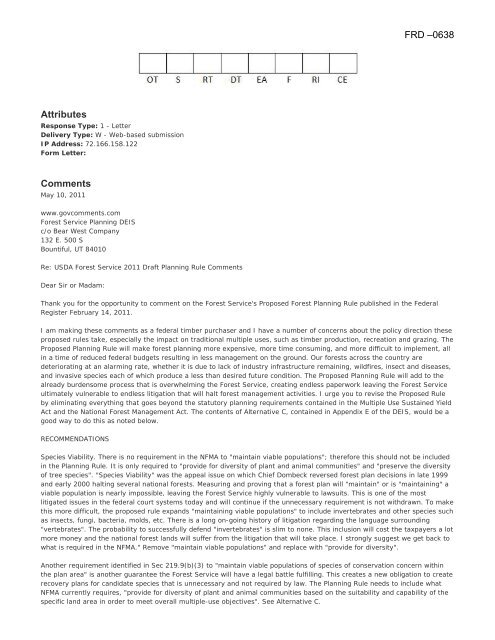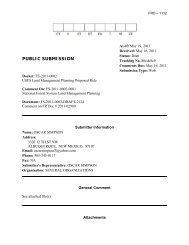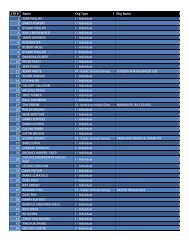FRD â0638 Attributes Comments - Content Analysis Group, LLC
FRD â0638 Attributes Comments - Content Analysis Group, LLC
FRD â0638 Attributes Comments - Content Analysis Group, LLC
Create successful ePaper yourself
Turn your PDF publications into a flip-book with our unique Google optimized e-Paper software.
<strong>FRD</strong> –0638<br />
<strong>Attributes</strong><br />
Response Type: 1 - Letter<br />
Delivery Type: W - Web-based submission<br />
IP Address: 72.166.158.122<br />
Form Letter:<br />
<strong>Comments</strong><br />
May 10, 2011<br />
www.govcomments.com<br />
Forest Service Planning DEIS<br />
c/o Bear West Company<br />
132 E. 500 S<br />
Bountiful, UT 84010<br />
Re: USDA Forest Service 2011 Draft Planning Rule <strong>Comments</strong><br />
Dear Sir or Madam:<br />
Thank you for the opportunity to comment on the Forest Service's Proposed Forest Planning Rule published in the Federal<br />
Register February 14, 2011.<br />
I am making these comments as a federal timber purchaser and I have a number of concerns about the policy direction these<br />
proposed rules take, especially the impact on traditional multiple uses, such as timber production, recreation and grazing. The<br />
Proposed Planning Rule will make forest planning more expensive, more time consuming, and more difficult to implement, all<br />
in a time of reduced federal budgets resulting in less management on the ground. Our forests across the country are<br />
deteriorating at an alarming rate, whether it is due to lack of industry infrastructure remaining, wildfires, insect and diseases,<br />
and invasive species each of which produce a less than desired future condition. The Proposed Planning Rule will add to the<br />
already burdensome process that is overwhelming the Forest Service, creating endless paperwork leaving the Forest Service<br />
ultimately vulnerable to endless litigation that will halt forest management activities. I urge you to revise the Proposed Rule<br />
by eliminating everything that goes beyond the statutory planning requirements contained in the Multiple Use Sustained Yield<br />
Act and the National Forest Management Act. The contents of Alternative C, contained in Appendix E of the DEIS, would be a<br />
good way to do this as noted below.<br />
RECOMMENDATIONS<br />
Species Viability. There is no requirement in the NFMA to "maintain viable populations"; therefore this should not be included<br />
in the Planning Rule. It is only required to "provide for diversity of plant and animal communities" and "preserve the diversity<br />
of tree species". "Species Viability" was the appeal issue on which Chief Dombeck reversed forest plan decisions in late 1999<br />
and early 2000 halting several national forests. Measuring and proving that a forest plan will "maintain" or is "maintaining" a<br />
viable population is nearly impossible, leaving the Forest Service highly vulnerable to lawsuits. This is one of the most<br />
litigated issues in the federal court systems today and will continue if the unnecessary requirement is not withdrawn. To make<br />
this more difficult, the proposed rule expands "maintaining viable populations" to include invertebrates and other species such<br />
as insects, fungi, bacteria, molds, etc. There is a long on-going history of litigation regarding the language surrounding<br />
"vertebrates". The probability to successfully defend "invertebrates" is slim to none. This inclusion will cost the taxpayers a lot<br />
more money and the national forest lands will suffer from the litigation that will take place. I strongly suggest we get back to<br />
what is required in the NFMA." Remove "maintain viable populations" and replace with "provide for diversity".<br />
Another requirement identified in Sec 219.9(b)(3) to "maintain viable populations of species of conservation concern within<br />
the plan area" is another guarantee the Forest Service will have a legal battle fulfilling. This creates a new obligation to create<br />
recovery plans for candidate species that is unnecessary and not required by law. The Planning Rule needs to include what<br />
NFMA currently requires, "provide for diversity of plant and animal communities based on the suitability and capability of the<br />
specific land area in order to meet overall multiple-use objectives". See Alternative C.
<strong>FRD</strong> –0638<br />
Sustainability. The Proposed Rule does not properly address the various multiple uses the Forest Service is required to<br />
manage for under the Multiple Use-Sustained Yield Act. Under Sec. 219.8 (b) Social and economic sustainability it states,<br />
"The plan must include plan components to guide the unit's contribution to social and economic sustainability…" , effectively<br />
placing ecological sustainability above the social and economic components. The language "contribution" renders the social<br />
and economic sustainability as secondary status and delivers the wrong message to the Forest Service about what they need<br />
to be doing managing natural resources such as timber, mining, and grazing. The Proposed Rule needs to recognize this and<br />
include language for plan components that maintain or restore all three elements of sustainability; ecological, social, and<br />
economical. Alternative C is the right approach.<br />
Role of Science. "Best available science" is identified throughout the Proposed Rules. Sec 219.3 "The responsible official shall<br />
take into account the best available scientific information throughout the planning process" seems relatively harmless. Having<br />
accurate, reliable and relevant information is crucial in Forest Service decision making and implementation, however, proving<br />
what science is "best" is likely to be time consuming and of little value, but will undoubtedly lead to lawsuits. Replace<br />
proposed Sec. 219.3 with the language in Alternative C.<br />
Public Participation. The public participation involvement process (Sec 219.4) is quite detailed and cumbersome and<br />
downplays the current requirement to coordinate with local government. NEPA requires that the analysis conducted be<br />
coordinated with local governments. The call for greater "public input" weakens the existing requirement to coordinate forest<br />
planning with local governments and their plans. Public involvement from all walks of life should be encouraged, but the local<br />
citizens and forest users that are most directly affected by the plan should have a greater influence on the future<br />
management decisions since they are the ones who live, work, play, and enjoy their adjacent federal lands each and every<br />
day. Too much emphasis is placed on using "contemporary tools" to engage the public and not enough emphasis given to the<br />
people who have to live with management decisions (or lack of) that may have great economic, social, and ecological<br />
impacts. Public outreach should be left to the discretion of the responsible official. See Alternative C.<br />
Process and Planning. The Proposed Rule places too much focus on planning, monitoring and assessing and not enough on<br />
objectives and desired future conditions (Sec. 219.5, 219.6, 219.7). These planning requirements are too time consuming<br />
and costly to implement considering the scarce resources and personnel availability. The goal of forest planning should be<br />
timely and efficient completion and implementation of plans, not endless planning. The process is not likely to improve our<br />
forests or make them easier to manage. We need to develop a strategy to make planning faster, simpler, less expensive as<br />
well as staying out of the court systems. Forest plans should be completed within three years of initiation, though the average<br />
10 year plan has taken 7-10 years to implement. The Proposed Rule adds additional levels of process that can only cause<br />
continued damage to our national forests. Only those processes required by Congress in the NFMA should be included in the<br />
Planning Rule.<br />
Assessments. The establishment of a new layer of planning identified in Sec 219.6 which would be prepared apart from the<br />
Forest Plan without NEPA analysis is a violation of the current law. This is another unnecessary process in the planning phase.<br />
I recommend eliminating Sec 219.6 and its requirements.<br />
Monitoring. The monitoring requirements proposed in Sec 219.12 are too complex, time consuming, and expensive; for<br />
instance, the regulation requires biennial monitoring evaluation reports and monitoring of "measurable changes related to<br />
climate change." Instead of focusing on "climate change and other stressors" and "carbon stored above ground" (Sec 219.1<br />
(a) 5 (v) & (vi), the Forest Service should place emphasis on other measurable items like timber outputs, AMU's, recreational<br />
visitor days, etc. identified in Sec 219.12(a)5. Monitoring should not be a Forest Plan requirement as it diverts more money<br />
and people from getting management done on the ground. The biennial evaluation discussed above should be eliminated. The<br />
language in Alternative C should be the Final Rule.<br />
Levels of Planning. I am extremely uncomfortable with the requirement in Sec 219.2(b) that "A plan reflects the unit's<br />
expected distinctive roles and contributions to the local area, region, and Nation, and the roles for which the unit is best<br />
suited, considering the Agency mission, unique capabilities, and the resources and management of other lands in the vicinity."<br />
Each forest plan produces a different mix of multiple use objectives and outputs. Identifying specific "niches", a term<br />
commonly used today, or "distinctive roles and contributions" for each forest to fill a void in the region or national picture will<br />
divert more attention than the tangible outputs, products, and services traditionally provided. The dynamics of each national<br />
forest change so frequently; whether it comes from a new listed endangered species, changes due to wildfire, insect and<br />
disease outbreaks, and mill closures, that the concept of having a distinctive role is unnecessary and quite honestly a<br />
distraction. Having a healthy forest addressing the multiple users' interest should be the direction each forest plan takes into<br />
account. Having a "distinctive role or contribution" assigned should not become required content of the plan. Each national<br />
forest needs to provide the resources and services that are desired at the local level. I believe that 219.2(b), 219.6(b)(3),<br />
and 219.7(e)(ii) requirements should be removed from the proposed rule in its entirety.<br />
Timber Requirements based on NFMA. The Proposed Rule needs to address and re-emphasize timber harvest on suitable<br />
lands providing forest products industry with dependable, predictable, sustained volumes. Timber harvest is the most cost<br />
effective tool to move or maintain the desired future conditions set out in the objectives of a forest plan. Timber harvest<br />
typically has been used to achieve other ecological benefits and multiple use benefits for purposes other than timber
<strong>FRD</strong> –0638<br />
production. The Forest Service is required by NFMA to remove timber annually in perpetuity on a sustained-yield basis.<br />
Perpetuity? Sustained? Accomplishments in most areas currently in the west are measured in road miles cleared, miles of<br />
power-lines cleared, sanitation, and salvage (after a wildfire or insect infestation), etc. How can we expect to maintain or<br />
sustain a healthy productive forest when the Forest Service is reactive instead of proactive? It appears all other needs take<br />
precedence over timber production. More emphasis needs to be given to timber production and be given equal consideration<br />
as to the important role it plays in providing for various multiple use benefits. A vibrant, healthy forest products industry<br />
needs to be a top priority to help restore/maintain healthy forest conditions, create jobs, and provide commodities our nation<br />
demands.<br />
COMMENDATIONS<br />
Pre-Decisional Administrative Review Process. I fully support the use of the pre-decisional objection process. Requiring<br />
objections before the final plan is released allows the Forest Service to consider changes before their final decision. Under the<br />
current appeals process, those who just want to stop a project don't have to participate in trying to resolve the issue before<br />
the decision is made. This process has worked well for Healthy Forest Restoration Act projects. The requirements of Sec.<br />
219.50—219.62 should be included in the final Planning Rule.<br />
Responsible official. I agree that the Forest Supervisor should be the Responsible Official who approves land management<br />
plans. (Sec. 219.2).<br />
Thank you for the opportunity to comment.<br />
Dan Buehler<br />
Resource Manager<br />
Neiman Timber Company L.C.<br />
P.O. Box 218<br />
Hulett, WY 82720<br />
Individual(s)<br />
Organization Type<br />
Organization<br />
Email Address<br />
Title<br />
Name<br />
Business (Affected Owner/CEO, Chamber of Commerce)<br />
NEIMAN TIMBER COMPANY L.C.<br />
danb@rapidnet.com<br />
RESOURCE MANAGER<br />
DAN BUEHLER<br />
Address 1 P.O. BOX 218<br />
Address 2<br />
City<br />
State<br />
HULETT<br />
WYOMING<br />
Zip 82720<br />
Country<br />
Created On<br />
UNITED STATES<br />
5/11/2011 9:17:00 AM





